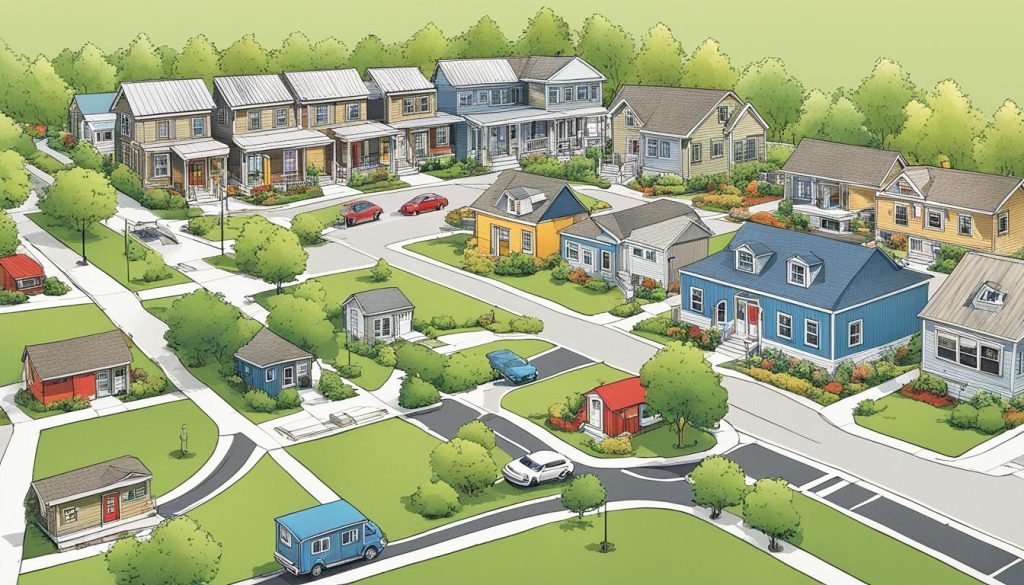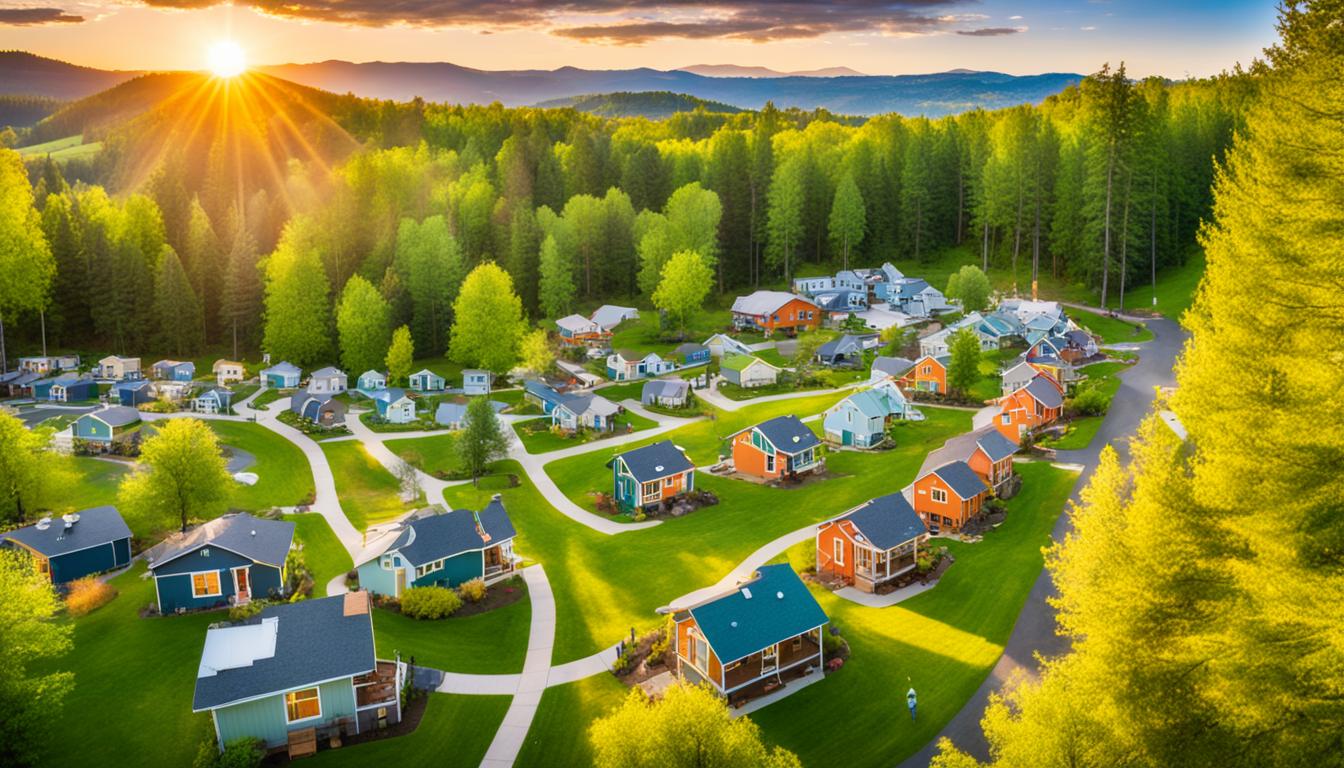Did you know that the number of people opting for tiny homes in Canada has been steadily increasing over the years? With the rise of compact living spaces and the desire for a simpler lifestyle, more individuals are seeking out tiny home parks and communities to call their own.
Finding a place to park your tiny home can be a challenge, but the good news is that there are more and more individuals and municipalities getting on board. We have helped match dozens of tiny house and RV dwellers with unique parking spots across British Columbia.
Key Takeaways:
- There is a growing demand for tiny homes in Canada.
- Finding a place to park your tiny home can be challenging but not impossible.
- We have assisted many individuals in finding the perfect tiny home park or community in British Columbia.
- Stay tuned to learn more about how to find available listings, considerations for placing a tiny home, the benefits of living in a tiny home, financing and construction options, sustainable features, and how to explore the tiny home lifestyle.
Finding Available Listings for Tiny Home Parks
When looking for a tiny home park near you, it’s important to check out available listings. There are people all over BC looking for places to park their tiny homes and RVs. You can often find listings from individuals who have room on their land for a tiny house or from small farms in need of part-time help. These listings provide information about the location, cost to rent, and any available amenities such as access to water, power, or septic.
- Check online platforms dedicated to tiny home communities and parks.
- Reach out to local real estate agents who specialize in alternative housing options.
- Join online forums and social media groups related to tiny home living to connect with individuals who may have available parking spaces.
- Visit local community centers or co-working spaces to gather information about potential tiny home park opportunities.
By exploring these avenues, you can increase your chances of finding a suitable tiny home park near you. Always make sure to thoroughly research and visit the potential locations to ensure they meet your needs and align with your vision of a tiny home lifestyle.
Considerations for Placing a Tiny Home
When it comes to finding the perfect spot for your tiny home, there are important factors to consider. Zoning regulations and building codes set by your local municipalities play a critical role in determining where you can place your tiny home. Familiarizing yourself with these regulations is essential to ensure a smooth and legal placement.
Depending on your area, you may have different options for parking your tiny home. Farms and rural properties often offer the space and tranquility that tiny home dwellers seek, providing a unique opportunity to live in close connection with nature. In urban areas, you may find opportunities to park your tiny home beside existing homes, creating a small house community right in the heart of the city.
However, it’s crucial to note that obtaining a permit is necessary regardless of the location you choose. Zoning regulations dictate the specific areas where tiny homes are permitted and outline any restrictions on land use. You’ll need to ensure that the property you select complies with these regulations.
Building codes are another important consideration. These codes establish the minimum standards for construction safety and quality. Your tiny home must meet these requirements to ensure the well-being of its occupants. It’s essential to work with professionals who are knowledgeable about these building codes to ensure that your tiny home is compliant and safe.
To summarize, when considering where to place your tiny home, it’s crucial to research and understand the zoning regulations and building codes set by your local municipalities. By doing so, you can find the perfect spot for your tiny home and ensure compliance with all necessary regulations.

Benefits of Living in a Tiny Home
Living in a tiny home offers a transformative experience, embracing a simpler, intentional way of life. It encourages mindful consumption and creative storage solutions.
One of the key benefits of tiny home living is the closer connection with nature. When you have a tiny home, you often have the opportunity to be more immersed in your natural surroundings. Whether it’s through large windows that let in abundant natural light or a cozy outdoor space that invites you to relax and enjoy the beauty of the outdoors, tiny homes help foster a deeper connection with nature.
But it’s not just about the physical environment. Tiny home living also promotes intentional living, where you prioritize experiences over possessions. With limited space, you’re forced to make conscious choices about what truly matters to you. This minimalist lifestyle allows you to focus on the things that bring you joy and fulfillment, rather than being bogged down by an abundance of material possessions.
In addition to the personal benefits, tiny home living also has a positive impact on the environment. By reducing the amount of space and resources needed to live comfortably, tiny homes have a significantly smaller environmental footprint compared to traditional homes. Many tiny homes are designed with sustainable features like energy-efficient appliances, solar power, and composting toilets, further reducing their environmental impact.
Living in a tiny home brings a sense of freedom and liberation. With fewer financial responsibilities and less time spent on maintenance, you gain the ability to focus on what truly matters to you. Whether it’s pursuing your passions, spending time with loved ones, or exploring new adventures, tiny home living provides the opportunity to live life on your own terms.
Discover the joys of a minimalist lifestyle, embrace intentional living, and reduce your environmental impact by embarking on the tiny home journey. Experience the freedom and possibilities that come with living in a smaller, more intentional space.
Financing and Construction of Tiny Homes
Owning a tiny home has become more accessible with flexible financing options available. Some companies offer assistance in obtaining loans for tiny homes, making it easier to fulfill your dream of owning a tiny home. When it comes to construction, it’s important to work with licensed professionals who can ensure that your tiny home is built to the highest standards. Additionally, many tiny home companies provide warranties for various components of the home, giving you peace of mind.
Flexible Financing Options
Financing a tiny home can be overwhelming, but there are solutions tailored to your needs. With numerous financing options available, you can explore loans specifically designed for tiny homes. These loans often have flexible terms and competitive interest rates, making them an attractive choice for aspiring tiny homeowners.
Licensed Professionals for Quality Construction
Building a tiny home involves intricate craftsmanship and attention to detail. It’s crucial to work with licensed professionals who specialize in building tiny homes. These experts have the expertise and knowledge to construct a structurally sound and aesthetically pleasing tiny home that meets or exceeds building codes and regulations.
Warranty for Peace of Mind
One of the advantages of purchasing a tiny home from a reputable company is the warranty protection it provides. Many tiny home companies offer warranties that cover different components of the house, such as the electrical system, plumbing, and appliances. This warranty gives you peace of mind and protects your investment in case of any unexpected issues.
By exploring the available financing options, working with licensed professionals, and securing a warranty, you can embark on your tiny home journey with confidence.
Sustainable Features of Tiny Homes
Tiny homes offer a multitude of sustainable features that make them an eco-friendly choice for those seeking a greener lifestyle. These small dwellings are designed with the goal of minimizing environmental impact and promoting sustainable living practices. Let’s explore some of the key sustainable features found in tiny homes:
Solar Power for Tiny Homes
One of the most prominent sustainable features of tiny homes is the integration of solar power systems. By harnessing the energy from the sun, tiny home dwellers can generate their own renewable electricity, reducing their reliance on traditional energy sources. Solar panels installed on the roof of the tiny home convert sunlight into usable energy, providing power for lighting, appliances, and other electrical needs. Embracing solar power allows for off-grid living and significantly decreases the carbon footprint associated with energy consumption.
Spray Foam Insulation in Tiny Homes
Spray foam insulation is another sustainable feature commonly found in tiny homes. This innovative insulation method provides superior thermal efficiency, effectively sealing any air leaks and creating a tightly insulated space. By minimizing heat transfer and maintaining a consistent indoor temperature, spray foam insulation reduces the energy required to heat or cool the tiny home. This translates to lower energy consumption and reduced environmental impact. Additionally, spray foam insulation improves indoor air quality by preventing the infiltration of allergens and pollutants, creating a healthier living environment.
Efficient Sewage Management Systems
Tiny homes are equipped with efficient sewage management systems that promote sustainable wastewater management. These systems are designed to treat and dispose of sewage in an environmentally friendly manner. Many tiny homes utilize composting toilets or low-flow toilets that minimize water usage. Composting toilets convert waste into usable compost, which can be safely used as fertilizer. Low-flow toilets reduce water consumption, conserving this valuable resource. By implementing efficient sewage management systems, tiny home dwellers contribute to sustainable water usage and lessen their impact on local water sources.

As you can see, sustainable living is a core principle of the tiny home movement. With features such as solar power systems, spray foam insulation, and efficient sewage management, tiny homes offer an environmentally conscious and socially responsible way of living. By adopting these sustainable practices, tiny home dwellers can reduce their carbon footprint, minimize energy consumption, and contribute to a more sustainable future for all.
Explore the Tiny Home Lifestyle
Are you ready to embark on a virtual tour of tiny homes and discover the possibilities of compact living? Look no further! Take a peek into various tiny home models and explore their unique features and layouts. From cozy cabins to modern eco-friendly designs, these virtual tours allow you to navigate and experience the charm of tiny home living right from the comfort of your own device.
But why stop at virtual exploration when you can dive deeper into the tiny home lifestyle? Schedule a free consultation with our experienced tiny home experts who can guide you through the benefits and possibilities of tiny home living. They can provide you with valuable insights, answer your questions, and help you make informed decisions about your tiny home journey.
To enrich your knowledge and immerse yourself in the tiny home community, don’t miss out on events and shows dedicated to tiny homes. These gatherings offer a wealth of information on zoning regulations, building codes, and other essential aspects of the tiny home movement. Engage with like-minded individuals, interact with industry professionals, and get inspired by innovative designs and sustainable living solutions.

Leave a Reply
You must be logged in to post a comment.